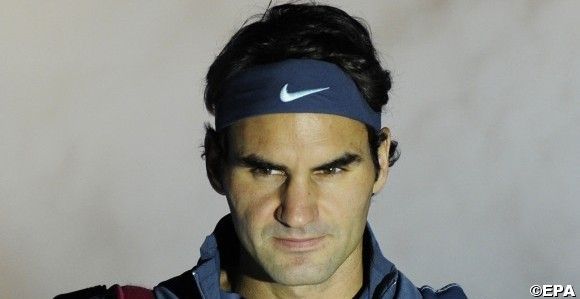The Federer Association By Ed Billett
 The Federer Association By Ed Billett
The Federer Association By Ed Billettepa03942510 Roger Federer from Switzerland arrives for his match against Juan Martin del Potro from Argentina during their group B singles match in the round robin stage at the Barclays ATP World Tour Finals in the O2 Arena in London, Britain, 09 November 2013. EPA/FACUNDO ARRIZABALAGA |
Some things simply belong together. Gin and tonic, fish with white wine, red wine paired with red meat, burgers and fries. Of course, these dualistic associations are not exclusive to the culinary sphere – such associations, often unknowingly, are present even in everyday language. Formulaic language in particular makes use of unconscious affiliation; contiguous phrases are so ingrained in our vocabulary that they are processed like a single unit – for instance, ‘refreshing breeze’ ‘ bodge job’ and ‘fast food’ are just a few examples of two word collocations with which we are so familiar that we recognise them on a macro, rather than micro level: we process such phrases as singular units rather than each word individually.
This notion of automatic association is also a truism in tennis. Wimbledon, for example, is immediately associated with strawberries and cream, the washed out British summer, and meticulous preparation, an attribute proudly reflected in the pristine condition of its grass courts and the ostentatiousness of the Lines officials’ apparel. However, unconscious affiliation can also be seen between players and tournaments. Tennis fans are aware that the French Open will be forever be linked with Rafael Nadal, an inextricably formed bond established by his record number of titles there, and the fact that it is the only clay court major, a surface on which Nadal has created an aura of near invincibility, sporting for the majority of the European clay court season the well known moniker, the ‘King of Clay’.
 Another such association is that between Roger Federer and the year-ending World Tour Finals. A tournament representative of only the very best players, it seems prudent that Federer should be present, not to mention the fact that he already owns a record six titles at the event. Federer was criticized before the tournament by Novak Djokovic, with the Serb suggesting that Federer is perhaps somewhat ‘slower’ than in years past. But whatever Federer may have lost in terms of athleticism, he more than accounts for any deficiencies with intelligence and artistry.
Another such association is that between Roger Federer and the year-ending World Tour Finals. A tournament representative of only the very best players, it seems prudent that Federer should be present, not to mention the fact that he already owns a record six titles at the event. Federer was criticized before the tournament by Novak Djokovic, with the Serb suggesting that Federer is perhaps somewhat ‘slower’ than in years past. But whatever Federer may have lost in terms of athleticism, he more than accounts for any deficiencies with intelligence and artistry.
For instance, Federer’s win over Richard Gasquet in the group stages felt almost like an exercise in aesthetics. With both players trading throwback one handed backhands, winding up on extravagantly produced swings, there were points within the match at which one wondered whether the players were actually trying to win the rallies, as opposed to provide an exhibition for the crowd. Like a well composed symphonic movement, the artistic brilliance of the match crescendoed mid way through the second set, when Federer saved break point by brilliantly lifting a backhand topspin lob over the head of the approaching Frenchman. It is at such moments one realises that even if Federer, as Djokovic suggested, cannot physically match his younger opponents, his aestheticism and virtuosity is near unparalleled – suggesting not only Federer’s affinity with the season ending championships, but also the fact that Federer still belongs at the top of the game.
Topics: 10sballs, Novak Djokovic, Rafael Nadal, Richard Gasquet, Roger Federer, Sports, Tennis, Tennis News


10sBalls Top Stories
- Reasons Behind the Increase in Sex Shops
- Reasons Behind the Increase in Sex Shops
- Reasons Behind the Increase in Sex Shops
- Casibom: Yaşayan Casinolar ve Bahisler Lider Platform
- Sea Star Casino: Play Games Without Registering Online
- JETZT DEN SWEET BONANZA SLOT GRATIS DREHEN
- Азартные игры с Мостбет Казино – испытайте удачу
- Çevrimiçi en iyi yuvalar: Hizmetinizde Karavan Bet Casino
- Top No Deposit Free Spins Offer for Canadians – December 2024
- Abe Bet Casino: Ücretsiz dönüşlerle heyecan hissedin
- Ünlü slotlar çevrimiçi kumarhanelerde başarı bet giriş ücretli formatta
- BasariBet Casino Giriş – En Güzel Canlı Casino Oyunlarına Katılın
- Игра на деньги в казино 1вин казино: безопасность
- De parking de credits sans oublier les Diction Casino Archive sauf que Perception
- Играть в хитовые слоты в надежных клубах azino777




